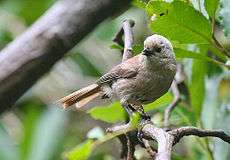Mohoua
| Mohoua | |
|---|---|
 | |
| Whitehead | |
| Scientific classification | |
| Kingdom: | Animalia |
| Phylum: | Chordata |
| Class: | Aves |
| Order: | Passeriformes |
| Family: | Mohouidae Mathews, 1946 |
| Genus: | Mohoua Lesson, 1837 |
Mohoua is a small genus of three bird species endemic to New Zealand. The scientific name is taken from either mohuahua or momohua – both Māori names for the Yellowhead.[1] Their taxonomic placement has presented problems: They have typically been placed in the Pachycephalidae family (whistlers), but in 2013 it was established that they are best placed in their own family, Mohouidae.[2]
All three species display some degree of sexual dimorphism in terms of size, with the males being the larger of the two sexes.[3] Mohoua are gregarious (more so outside the breeding season) and usually forage in groups . They also forage in mixed species flocks at times, frequently forming the nucleus of such flocks.[1] Social organization and behaviour is well documented for all three Mohoua species; cooperative breeding has been observed in all three species and is common in the Whitehead and Yellowhead.[1] The three species of this genus are the sole hosts for the Long-tailed Cuckoo which acts as a brood parasite upon them, pushing their eggs out of the nest and laying a single one of its own in their place so that they take no part in incubation of their eggs or in raising their young.[3]
Species
- Whitehead, Mohoua albicilla – (Lesson, 1830)
- Pipipi, or Brown Creeper, Mohoua novaeseelandiae – (Gmelin, 1789)
- Yellowhead, Mohoua ochrocephala – (Gmelin, 1789)
References
- 1 2 3 "Handbook of Australian, New Zealand and Antarctic Birds"; Volume 7, edited by Peter Higgins, OUP, 2000
- ↑ Zachary Aidala et al. Phylogenetic relationships of the genus Mohoua, endemic hosts of New Zealand’s obligate brood parasitic Long-tailed Cuckoo (Eudynamys taitensis). Journal of Ornithology, published online June, 2013; doi: 10.1007/s10336-013-0978-8
- 1 2 Barrie Heather and Hugh Robertson, "The Field Guide to the Birds of New Zealand" (revised edition), Viking, 2005
- Del Hoyo, J.; Elliot, A. & Christie D. (editors). (2007). Handbook of the Birds of the World. Volume 12: Picathartes to Tits and Chickadees. Lynx Edicions. ISBN 978-84-96553-42-2